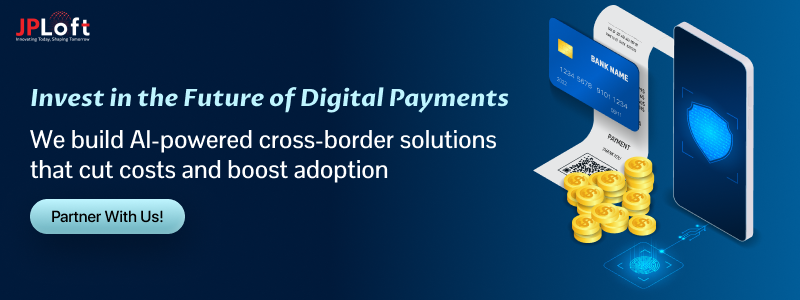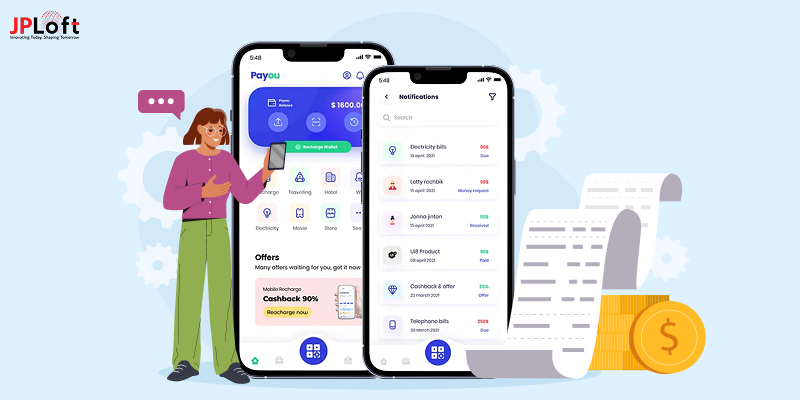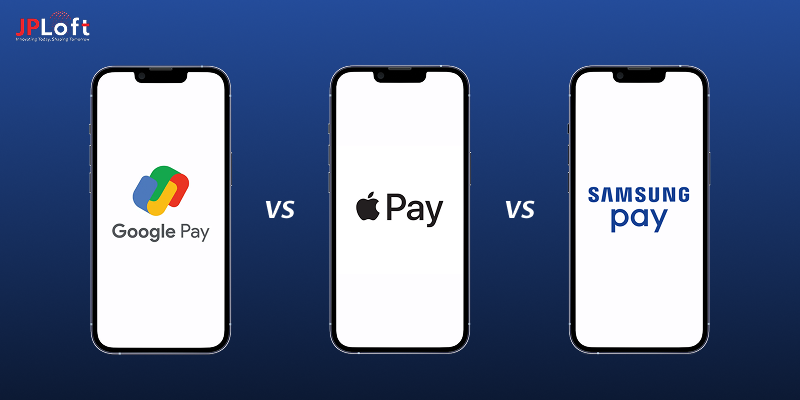Key Takeaways:
AI in cross-border payments boosts speed, security, and cost-efficiency for global transactions.
Machine learning, NLP, and blockchain streamline fraud detection, compliance, and currency optimization.
Automated workflows reduce fees, processing time, and operational costs while enhancing user satisfaction.
Clear objectives, quality data, and continuous monitoring ensure scalable, reliable AI-powered solutions.
Partnering with experts like JPLoft enables seamless integration and optimized cross-border payment performance.
Remember the old days of sending money internationally? High fees, days-long waits, and that sinking feeling that your cash had vanished into a bureaucratic black hole.
Those days are over. Artificial Intelligence (AI) is transforming cross-border payments, making them faster, smarter, and more secure.
The global market is already massively valued at nearly $200 billion in 2024 and projected to grow at a 7% CAGR through 2032.
Top institutions are using AI to detect fraud in real time, optimize currency conversions, and automate compliance, tackling challenges that once seemed impossible.
AI isn’t just improving payments, it’s revolutionizing them, turning delays and costs into seamless, near-instant global transactions.
Let’s get to know it all in this blog:
AI in Cross-Border Payments Explained
Cross-border payments have long been associated with high fees, slow settlement times, and complex regulatory barriers.
Artificial Intelligence (AI) is changing this narrative by bringing automation, accuracy, and smarter decision-making into the process.
With AI-powered systems, financial institutions can detect fraud in real time, predict currency fluctuations, and streamline compliance checks, making global transactions faster and more reliable.
This innovation is especially crucial for businesses and individuals relying on international money transfers.
When you create an eWallet app with AI-driven features, you unlock the ability to offer seamless cross-border transactions without the typical hurdles of delays and heavy costs.
AI algorithms analyze transaction patterns to reduce risks, optimize exchange rates, and ensure compliance with multiple jurisdictions.
The result is an intelligent eWallet solution that provides customers with transparency, security, and convenience—three pillars essential for thriving in the competitive global payments ecosystem.
Why It Matters:
AI doesn’t just simplify the process; it redefines the future of global money movement.
By leveraging AI, businesses can lower operational costs, accelerate transaction speed, and ensure better regulatory alignment.
For startups, this technology makes it possible to compete with established global players by offering smarter, safer, and more user-friendly solutions.
In short, AI transforms cross-border payments from a cumbersome necessity into a strategic advantage.
How AI Differs From Traditional Payment Systems?
Traditional cross-border payments depend on banks and middlemen. That means longer waiting times, higher fees, and more chances of errors.
AI flips that model on its head.
-
It automates compliance checks that used to take days.
-
It scans for fraud instantly instead of after the fact.
-
It predicts exchange rates to give you smarter conversions.
The result? Faster settlements, fewer headaches, and more confidence in every transaction.
Refer to this table for a better understanding:
|
Aspect |
Traditional Cross-Border Payments |
AI-Powered Cross-Border Payments |
|
Speed |
Takes days to settle transactions |
Settles payments almost instantly |
|
Cost |
Higher fees due to intermediaries |
Lower fees with optimized routes |
|
Fraud Detection |
Reactive, after fraud occurs |
Real-time fraud detection & prevention |
|
Compliance Checks |
Manual, slow, and error-prone |
Automated and accurate |
|
Currency Conversion |
Fixed or less favorable rates |
Predictive, optimized exchange rates |
Key AI Technologies Behind Cross-Border Payments
AI in payments isn’t just a single innovation; it’s a combination of advanced technologies working together to transform how global money movement happens.
Let’s break down the most important ones:
1. Machine Learning (ML) in Payments
Machine Learning is the backbone of AI-powered payments.
It studies past transaction patterns to detect fraud, predict risks, and recommend the best routes for international transfers. This reduces errors and makes the process smoother for both businesses and users.
If you’re planning to launch your own payment solution, investing in machine learning development services helps you launch an eWallet that can prevent fraud before it happens and offer personalized user experiences.
2. Natural Language Processing (NLP) for Global Support
Cross-border payments mean dealing with users from different countries and languages. That’s where NLP comes in.
It powers AI chatbots, multilingual support, and voice assistants, helping customers resolve payment issues instantly without waiting for a human agent.
Companies looking to expand internationally can leverage NLP development services to build smarter customer support systems. This not only improves user satisfaction but also builds trust in your platform.
3. Blockchain Integration in Payments
Blockchain adds another layer of strength to AI-driven payments. It ensures every transaction is transparent, traceable, and tamper-proof.
By combining AI with blockchain, you get faster settlements, secure storage of transaction data, and compliance with global regulations.
If you want to innovate in this space, working with blockchain development services allows you to integrate decentralized technology into your payment system, making it future-ready and highly secure.
Now that we’ve explored the key technologies driving Artificial Intelligence in cross-border payments, let’s take a step forward and look at some market statistics that reveal the real picture of this growing industry.
Market Landscape: $290 Trillion Opportunity by 2030
Cross-border payments with AI are evolving, and digital wallets are at the forefront. eWallet app stats reveal a sharp rise in adoption, highlighting the enormous potential for platforms offering AI-powered, secure, and instant international transfers:
-
According to Grand View Research, the global cross-border payments market was valued at USD 212.55 billion in 2024 and is projected to reach USD 320.73 billion by 2030, growing at a CAGR of ~7.1%.
-
For the B2B cross-border payments segment, they report USD 31.6 trillion for 2024, growing 58% to USD 50 trillion by 2032 (CAGR ~5.9%)
-
EY mentions that global payments (not just cross-border) might hit USD 290 trillion by 2030 as digital innovation drives growth in transaction volume.
-
Visa prevented $40 billion worth of fraudulent transactions in 2023 through advanced technological investments, including artificial intelligence (AI)
These figures illustrate how AI is being increasingly embraced in cross-border payments to streamline processes and enhance efficiency.
How AI Works in Cross-Border Payments?
Wondering how AI works in cross-border payments?
Here’s a clear, step-by-step look at how Artificial Intelligence is transforming cross-border payments and making global transactions faster, safer, and more efficient:
Step 1: Data Collection & Analysis
AI gathers transaction data from multiple sources, including payment histories, currency trends, and regulatory rules. This allows for accurate, real-time insights for every transfer.
Step 2: Fraud Detection & Risk Assessment
Machine learning algorithms detect unusual patterns, flag suspicious activity, and instantly reduce fraud risks, which is essential in cross-border transactions.
Step 3: Currency Optimization
AI predicts favorable exchange rates and suggests optimal conversion strategies, helping businesses save money and improve efficiency.
Step 4: Automated Compliance
Compliance checks are automated to meet each country’s regulations, reducing errors and manual effort.
Step 5: Instant Settlement & Reporting
Transactions are executed quickly, with real-time reporting and analytics for transparency.
For those looking to start an online ewallet business, leveraging AI cross-border payments technology can give a competitive edge while ensuring seamless operations.
Key AI Applications in Cross-Border Payments
Let’s face it; sending money internationally used to be slow, expensive, and complicated. But with AI applications in cross-border payments, that’s changing fast.
These intelligent systems are making transactions smoother, safer, and way faster.
From spotting fraud before it happens to optimizing currency exchanges, AI in cross-border payments is now at the heart of modern financial systems.
And the best part? It’s not just for big banks-you can leverage these tools for your digital wallets or eWallet platforms to deliver a seamless experience for your users.
1] Fraud Detection and Risk Management
Fraud is the nightmare of cross-border payments.
But with AI cross-border payments, you don’t have to worry as much. Machine learning algorithms analyze transaction patterns continuously to detect anything unusual.
Real-time anomaly detection spots suspicious activity instantly, while risk scoring algorithms prioritize which transactions need closer attention.
Case studies show AI can reduce fraud losses by over 40%, which means enhanced eWallet app security for your users.
Key Highlights:
-
Instant alerts prevent fraudulent transfers before they can cause harm.
-
Historical data analysis helps AI predict and prevent new types of fraud.
-
AI creates a secure environment, building trust with your customers.
2] Automated Compliance and Regulatory Reporting
Keeping up with AML/KYC rules across multiple countries can be exhausting. That’s where the use of Artificial Intelligence in cross-border payments comes in.
AI systems automate compliance checks, adapting quickly to new regulations. They streamline reporting, reduce errors, and save you time-no more drowning in paperwork.
And if you’re building or managing an eWallet, eWallet app compliance becomes much simpler.
Key Highlights:
-
Cross-border compliance challenges are resolved efficiently with AI.
-
Automated documentation cuts down manual work for your team.
-
AI ensures you’re always audit-ready without extra stress.
3] Dynamic Foreign Exchange Rate Optimization
Currency exchange can make or break your profit margins. Luckily, AI apps in cross-border payment platforms predict FX rates hourly and suggest the best conversion strategy.
Automated currency hedging reduces losses, while real-time market analysis ensures transactions happen at the most favorable rates.
For high-volume international payments, this adds up to serious savings.
Key Highlights:
-
Continuous monitoring of FX rates keeps your business ahead of fluctuations.
-
Smart algorithms optimize each transaction, maximizing value for your users.
4] Intelligent Payment Routing and Settlement
Ever wished money could take the fastest route across the globe? That’s exactly what AI in cross-border payments does.
AI analyzes multiple payment rails and selects the quickest, most cost-effective path. Settlement times drop, network efficiency improves, and your users enjoy near-instant transfers.
Key Highlights:
-
Bottlenecks are identified and resolved automatically.
-
Adaptive routing keeps transactions smooth, even during peak times.
5] Predictive Liquidity Management
Managing cash flow across borders is tricky, but AI cross-border payments make it manageable. AI forecasts liquidity needs, optimizes working capital, and automates funding decisions.
This means your business always has enough funds available for operations, while avoiding idle cash sitting unnecessarily.
Key Highlights:
-
Predictive analytics help prevent liquidity shortages.
-
Automated funding decisions reduce manual errors and save time.
6] Customer Experience Enhancement
Your users want fast, transparent, and personalized payments. AI helps deliver that.
AI in cross-border payments can recommend payment methods, integrate chatbots for instant support, and give users clear transaction visibility.
For super apps in eWallet, this creates a seamless, engaging experience that keeps customers coming back.
Key Highlights:
-
AI-driven support reduces response times dramatically.
-
Personalized suggestions increase engagement and loyalty.
7] Real-Time Payment Processing
Nobody likes waiting for international payments. With AI applications in cross-border payments, you get instant settlement. Real-time payment processing, backed by robust digital wallet APIs, ensures reliability even under heavy load.
Your users can see transactions happen in real-time, building trust and satisfaction.
Key Highlights:
-
Instant confirmations enhance customer confidence.
-
AI maintains network stability during peak transaction volumes.
8] Blockchain and Stablecoin Integration
Want to go beyond traditional rails?
AI-enhanced blockchain payments allow smart contracts and stablecoin optimization for cross-border settlements. Hybrid solutions combine speed, security, and cost-efficiency.
For anyone planning funding for your eWallet app, integrating AI with blockchain gives you a competitive edge while reducing currency volatility risks.
Key Highlights:
-
AI monitors blockchain transactions for anomalies.
-
Stablecoin optimization ensures smoother cross-border transfers.
-
Hybrid payment systems increase flexibility and reduce costs.
Top Benefits of AI in Cross-Border Payments
If you’re exploring the benefits of AI cross-border payments, it’s clear that this technology is more than just a convenience-it’s a strategic advantage.
AI in cross-border payments streamlines operations, reduces costs, strengthens security, and improves compliance.
For businesses and investors alike, AI transforms cross-border payment systems into high-performing engines that maximize efficiency, minimize risk, and deliver measurable ROI.
Let’s get to know more benefits of it:
1. Cost Reduction Metrics
One of the biggest advantages of AI in cross-border payments is its ability to reduce costs.
AI automation significantly lowers transaction fees, with some platforms reporting reductions of 20–30% per transfer. Operational costs also drop as manual intervention becomes minimal.
Automated compliance checks reduce reporting errors, saving additional costs and improving efficiency.
Overall, the total cost to develop an eWallet app with AI-powered systems is far lower than traditional methods, making it a smart long-term investment for fintechs and banks alike.
How it Helps:
-
Transaction fees are reduced significantly.
-
Operational costs drop thanks to automation.
-
Compliance costs are optimized with AI-driven reporting.
2. Speed and Efficiency Improvements
Time is critical in global payments.
Benefits of Artificial Intelligence in cross-border payments include dramatically faster settlements and processing speeds.
Tasks that once took days can now be completed in minutes, thanks to automated workflows and intelligent routing.
By integrating AI into your systems, you also gain performance consistency, avoiding delays even during peak transaction periods.
For super apps in eWallet, this efficiency translates to happier users and stronger retention.
How it Helps:
-
Settlement times are drastically reduced.
-
Automation boosts processing efficiency across the board.
-
AI ensures smooth operations during high-volume periods.
3. Enhanced Security and Fraud Prevention
Security is non-negotiable. Advantages of AI in cross-border payments include advanced fraud detection and predictive risk assessment.
AI monitors patterns in real-time, spotting anomalies and preventing fraud before it happens.
For digital wallets and financial services, this means your customers’ funds are protected, your app security is strengthened, and trust is built. Investors also see reduced exposure to financial and reputational risk.
How it helps:
-
Fraud detection accuracy is significantly higher than traditional methods.
-
Real-time monitoring reduces incidents and potential losses.
-
Risk mitigation improves customer confidence and retention.
4. Regulatory Compliance
Compliance is a major headache for global payments, but AI makes it manageable.
Benefits of AI cross-border payments include automated AML/KYC checks, precise reporting, and a full audit trail for regulators.
With AI, errors are minimized, penalties are avoided, and regulatory obligations are consistently met. For fintech ventures, this translates to smoother operations, cost efficiency, and enhanced credibility.
How it Helps:
-
Automated compliance reduces human error.
-
AI helps avoid regulatory penalties and fines.
-
Complete audit trails improve transparency and trust.
5. Predictive Analytics for Strategic Decision-Making
AI applications in cross-border payments don’t just process transactions–they provide insights. Predictive analytics allow you to forecast trends, identify high-risk corridors, and optimize cash flow.
By analyzing historical and real-time data, AI helps you make smarter decisions, allocate resources efficiently, and improve overall profitability.
For investors, predictive capabilities mean better risk management and more informed growth strategies.
How it helps:
-
Predict future transaction trends for better planning.
-
Identify and mitigate risks proactively.
-
Allocate resources more effectively for maximum ROI.
6. Personalized User Experience
With AI in cross-border payments, you can tailor services to each customer. Personalized recommendations, preferred payment methods, and seamless interfaces enhance engagement.
This creates loyal users who are more likely to transact frequently and trust your platform. Personalized experiences also boost adoption rates and lifetime value.
How it helps:
-
Offer customized payment suggestions to users.
-
Increase user retention and engagement.
-
Boost transaction frequency and satisfaction.
7. Scalability and Future-Proofing
As your business grows, AI cross-border payments scale effortlessly.
Automated workflows, intelligent routing, and predictive resource management ensure your system can handle increasing volumes without sacrificing speed or security.
For investors, this means long-term value: a platform that’s ready for growth and adaptable to future market demands.
How it helps:
-
Easily scale operations without adding manual overhead.
-
Maintain efficiency even during high-volume periods.
-
Future-proof your payment infrastructure for growth.
With that covered, let’s explore how AI can be effectively implemented in cross-border payments.
Implementation Guide: How to Deploy AI in Cross-Border Payments
AI in cross-border payments has tremendous advantages, including detecting fraud, optimizing currency conversions, and improving overall customer experience.
This is why businesses want to know how to implement AI in cross-border payments, which is what this section is all about.
Let’s get to know it all in this section:
Step 1: Define Objectives and Use Cases
Before you dive into implementing AI in cross-border payment apps, take a moment to clarify what you want AI to achieve.
Ask yourself: do you want faster transactions, better fraud detection, or smarter currency conversion predictions? Maybe all three. Clear objectives help you focus your efforts and select the right AI models.
Think about practical applications, like automating repetitive tasks, detecting unusual payment patterns, or assessing risk in real time. When you define these goals upfront, you’re not just implementing technology; you’re creating solutions that add measurable value to your business.
Step 2: Collect and Prepare Data
AI is only as good as the data it learns from. Start gathering all the relevant payment history, transaction logs, and customer behavior insights that your systems can provide.
Cleaning and structuring this data is key; you want to remove errors, standardize formats, and organize it so AI can actually make sense of it.
The more accurate and comprehensive your data, the smarter your AI will become.
When you integrate AI in cross-border payment apps with clean, structured data, you’re setting yourself up for faster learning, better predictions, and fewer errors, saving you time and money in the long run.
Step 3: Choose the Right AI Technology
Now it’s time to pick the tools and algorithms that match your goals.
Machine learning can spot patterns and prevent fraud before it happens. Natural language processing (NLP) can improve customer support with chatbots or automated responses.
Think about scalability, too. You don’t want a solution that works today but struggles when your transaction volume doubles. By choosing the right ewallet app technology stack, you ensure your AI can grow alongside your business.
This step is crucial if you want to implement AI in cross-border payment apps that truly make a difference for your customers.
Step 4: Integrate AI into Your App
Integrating AI or Gen AI in your e-wallet app is where your ideas go from theory to reality.
Integration is where your AI goes from theory to practice.
Connect your AI system with your existing payment platforms, banking partners, and compliance frameworks.
API-based connections are usually the easiest way to keep everything running smoothly.
During this stage, you want to make sure that transactions remain seamless, secure, and fast.
When you integrate AI in cross-border payment apps, it should feel invisible to the user, enhancing the experience without adding friction.
Proper integration also means your AI can interact with other systems in real time, improving decision-making and operational efficiency.
Step 5: Test and Optimize
You’ve set it up, now let’s make sure it works.
Test your AI in real-world scenarios, running transactions just like your users would. Monitor for accuracy, speed, and any false positives in fraud detection.
Optimization is ongoing. AI learns and improves over time, but only if you feed it the right feedback. Tweaks and refinements help it adapt to changing patterns and keep delivering reliable results.
By app testing, you ensure that your AI doesn’t just run-it excels, creating a smoother, faster, and more secure experience for everyone using your cross-border payment solution.
Step 6: Monitor Performance and Update
Deployment isn’t the end-it’s just the beginning of app maintenance services.
Keep an eye on key metrics like transaction speed, fraud prevention effectiveness, and overall customer satisfaction. Regular monitoring allows you to spot trends and identify areas for improvement.
Continuous feedback and learning are essential to grow your business. As trends in eWallet apps evolve, your AI needs to evolve too. Regular updates and fine-tuning ensure your solution stays ahead of the curve and keeps your users happy.
By actively monitoring and updating your system, you’re not just maintaining performance-you’re future-proofing your AI-powered cross-border payment app for long-term success.
Top AI Cross-Border Payment Companies and Solutions
In 2025, the landscape of cross-border payments is being reshaped by artificial intelligence, with numerous companies leveraging AI to enhance efficiency, security, and user experience.
Among the best AI cross-border payment companies, several stand out for their innovative approaches and impactful solutions.
Let’s get to know the top ewallet apps that are leveraging Artificial Intelligence in ewallet apps:
1. PayPal
Founded in 1998, PayPal has evolved from a simple online payment platform to a global leader in digital commerce.
If your goal is to create a payment platform like PayPal, you'd study their 2025 innovation: PayPal World. This groundbreaking initiative enhanced cross-border payments through AI integration and strategic collaborations.
AI Integration: PayPal World leverages AI to enable seamless interoperability between various digital wallets and payment systems worldwide. This platform allows users to make payments across borders using their preferred local wallets, facilitating smoother international transactions.
Impact: PayPal’s AI-driven cross-border solutions have made international transactions faster, more secure, and highly convenient for users worldwide.
Businesses and individuals can now send and receive payments globally with lower fees and enhanced reliability.
2. Wise (formerly TransferWise)
Founded in 2011 by two Estonian entrepreneurs, Wise began with a mission to make international money transfers more transparent and affordable. They leveraged peer-to-peer technology to bypass traditional banking fees.
AI Integration: In 2025, Wise has enhanced its platform with AI-driven algorithms that optimize currency exchange rates in real-time. This ensures users get the best possible rates, reducing costs and improving transaction speed.
Impact: Wise's AI enhancements have significantly improved user satisfaction by providing quicker and more cost-effective transfers, solidifying its position as a leader in the cross-border payment space.
Entrepreneurs and fintech innovators looking to develop an app like Wise can take inspiration from its AI-powered efficiency and user-centric design.
3. Revolut
Launched in 2015 in the UK, Revolut started as a digital banking alternative offering currency exchange and global spending. It quickly expanded its services to include stock trading, crypto, and insurance.
AI Integration: Revolut employs AI to analyze spending patterns, detect fraudulent activities, and provide personalized financial advice. Its AI-powered chatbots assist customers 24/7, enhancing user experience.
Impact: The integration of AI has allowed Revolut to offer tailored financial services, improving customer engagement and trust, and positioning it as a formidable player in the fintech industry.
4. Payoneer
Established in 2005, Payoneer provides cross-border payment solutions to businesses of all sizes. It enables companies to send and receive funds globally as easily as they do locally.
AI Integration: Payoneer utilizes AI to streamline compliance processes, detect fraud, and optimize payment routing. This reduces transaction times and costs, making international payments more efficient.
Impact: By harnessing AI, Payoneer has improved operational efficiency, allowing businesses to focus on growth while ensuring secure and timely payments.
5. Thunes
Founded in 2016, Thunes aims to simplify cross-border payments by connecting businesses and financial institutions across emerging markets. It provides a global payment network that facilitates seamless transactions.
AI Integration: Thunes employs AI to enhance payment routing, ensuring funds are delivered quickly and securely. Its AI systems also monitor transactions in real-time to detect and prevent fraud.
Impact: Thunes' AI-driven approach has expanded its reach, enabling businesses in emerging markets to access global payment solutions, fostering economic inclusion.
6. Ripple
Ripple, established in 2012, focuses on enabling real-time global payments using blockchain technology. Its network, RippleNet, connects banks and payment providers worldwide.
AI Integration: Ripple integrates AI to predict optimal payment routes and manage liquidity. This enhances the efficiency of cross-border transactions, reducing costs and settlement times.
Impact: By combining blockchain and AI, Ripple has revolutionized cross-border payments, offering a faster and more transparent alternative to traditional banking systems.
7. Alipay+
Launched by Ant Group, Alipay+ is a global mobile payment platform that connects users to various local and international payment services. It aims to facilitate seamless cross-border transactions for consumers and businesses.
AI Integration: Alipay+ utilizes AI to offer personalized payment experiences, detect fraudulent activities, and optimize transaction processes. Its AI capabilities ensure secure and efficient cross-border payments.
Impact: With AI at its core, Alipay+ has expanded its services globally, enabling seamless cross-border transactions. Businesses looking to create a payment platform can learn from its innovative approach to enhancing the global digital economy.
With these companies making breakthroughs in the market through AI integrations, your business can be next on the list. However, building an app with AI comes with its own set of challenges.
Challenges and Limitations of AI Cross-Border Payments
Implementing AI in global payment systems brings incredible advantages, but businesses must navigate several hurdles.
Understanding AI cross-border payments implementation challenges helps prepare for smoother adoption and sustainable growth.
Let’s explore these challenges one by one:
Challenge 1: Regulatory Compliance
Navigating different financial regulations, tax laws, and anti-money laundering requirements across countries can slow down AI adoption.
Solution: Integrate compliance checks within your AI system and collaborate with legal experts to ensure all cross-border transactions meet local regulations.
Challenge 2: Data Privacy and Security
Handling sensitive financial data globally increases the risk of breaches and non-compliance with privacy laws like GDPR.
Solution: Employ advanced encryption, secure cloud storage, and real-time monitoring to protect user data while maintaining AI efficiency.
Challenge 3: Currency Exchange Volatility
Rapid fluctuations in currency rates can reduce profit margins and affect transaction accuracy.
Solution: AI algorithms must be trained to predict trends, optimize exchange rates, and provide dynamic adjustments in real-time.
Challenge 4: Integration with Legacy Systems
Many financial institutions rely on outdated infrastructure that’s difficult to integrate with AI-driven solutions
Solution: Use modular AI architecture and APIs to ensure seamless integration with existing banking and payment systems without disrupting operations.
Challenge 5: User Trust and Adoption
Users may hesitate to trust AI for high-value international transactions due to perceived risks.
Solution: Implement transparent AI decision-making, fraud detection, and clear communication of safety features to build confidence and encourage adoption.
Challenge 6: Operational Costs and Scalability
Developing, deploying, and maintaining AI for cross-border payments can be expensive and resource-intensive.
Solution: Focus on scalable cloud-based AI solutions, automate repetitive processes, and gradually expand features to optimize cost-efficiency.
With the key challenges in digital wallet apps outlined, let’s now explore the emerging trends shaping the future of cross-border payments.
Future: AI Cross-Border Payments in 2025-2030
The future of AI cross-border payments promises faster, smarter, and more secure international transactions.
Emerging technologies like predictive analytics, real-time fraud detection, and AI-driven dynamic currency conversion will transform the way businesses and consumers handle money globally.
Mobile wallets and digital banking platforms are increasingly adopting AI, making financial services more personalized and efficient.
Entrepreneurs and fintech innovators must stay updated on future trends in e-wallet apps, including automation, blockchain integration, and voice-enabled payments, to remain competitive.
By leveraging AI intelligently, businesses can reduce costs, minimize errors, and deliver seamless, user-centric experiences across borders.
How JPLoft Can Help You Smoothly Integrate AI in Cross-Border Payment?
Integrating AI into cross-border payments requires expert knowledge and reliable execution.
As a leading ewallet app development company, JPLoft helps businesses design, develop, and deploy AI-powered payment solutions that optimize currency exchange, detect fraud, and enhance transaction speed.
Our team ensures seamless integration with legacy systems, compliance with international regulations, and user-friendly interfaces.
By partnering with JPLoft, companies can accelerate adoption, improve operational efficiency, and deliver secure, scalable, and intelligent cross-border payment experiences that delight users worldwide.
Conclusion
Implementing AI in global payments is no longer optional-it's a strategic necessity. Businesses looking to implement AI in cross-border payment apps can benefit from predictive algorithms, faster settlements, and fraud prevention.
AI enhances user satisfaction by providing real-time insights, secure transactions, and efficient currency conversion.
With proper planning, expert guidance, and technology integration, companies can build scalable and competitive platforms.
Strategic AI adoption transforms payment solutions into smarter, more reliable, and cost-effective systems that strengthen global financial networks while ensuring a seamless, user-centric experience for both individuals and enterprises.
FAQs
AI cross-border payments use artificial intelligence to optimize international transactions, including currency conversion, fraud detection, and transaction speed, enhancing efficiency and accuracy.
AI improves operational efficiency, reduces errors, provides predictive insights, and enhances security, making cross-border payment apps faster, more reliable, and user-friendly.
As an app development company, JPLoft designs, develops, and integrates AI-driven features to ensure secure, scalable, and seamless cross-border payment experiences.
Trends include AI-driven personalization, blockchain integration, voice-assisted payments, predictive analytics, and automation to improve security, usability, and transaction speed.
Challenges include regulatory compliance, data security, currency volatility, integration with legacy systems, and operational costs. Expert guidance ensures smooth implementation and adoption.












Share this blog